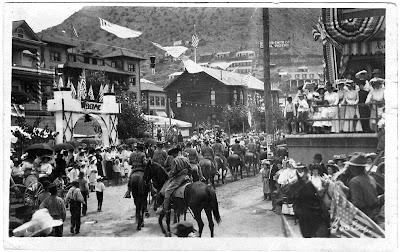 |
| Bisbee, Arizona celebrates the 4th of July in 1909 |
Arizona was
the last contiguous state to join the Union. That probably should be rephrased
as the last state allowed to join the Union. Arizona became a full-fledged
state on February 14th, 1912. At the time, the population was around
200,000, but it was not the wide open spaces that held Arizona back. After all,
Nevada became a state in 1864 with a population of less than 20,000. What was
the deference between these two desert states?
Nevada had
two things Washington mucky-mucks desperately wanted: the Comstock Lode and electoral
votes to help reelect Lincoln to a second term. Money and votes—what
could be more enticing to a politician? Between 1859 and 1865 an estimated $50
million in ore was removed from the earth. Quite a haul. But wait a minute; Tombstone
produced 32 million troy ounces of silver valued at between $40-85 million, which in
today’s dollars would be worth about $2 billion. Wasn’t that enough to
warrant an invitation to the club?
Actually, statehood looked close around 1880. In the great West,
Tombstone was only behind San Francisco in commerce and culture. As early as
1877, Arizona Territorial Governor A. P. K. Safford predicted that the
Territory "will soon become a State." What happened?
 |
| October 26, 1881 |
The gunfight at the O.K. Corral is what happened. This fight and the
aftermath were reported by all of the Eastern tabloids of the day and the
reputation of Arizona was reset in a few deadly seconds. How could Congress
welcome a lawless wasteland into the Union? (No snickers.) By the time
Arizona was finally admitted, the silver had played out and Tombstone was nearly
a ghost town. So, shunning Arizona can be blamed on the Earps or the cow-boys,
depending on which side of the feud you prefer.